Last week, I discovered that two of the most frequently asked questions we receive are “How can I stay in touch with my IM buddies on my mobile phone?” and “How can I make VoIP calls from my mobile phone?”
So, earlier in the week, fresh from a vacation break, I set out in my quest for the perfect IM client & the perfect VoIP client for mobile phones. I found the solution to *both* the problems in fring.
fring is an IM client that runs on Symbian and Windows mobile phones. So what’s the big deal with that, you ask. Well, consider this:
— fring supports *all* major IM networks: Skype, MSN (Windows Live) Messenger, Yahoo, ICQ, AIM and Gtalk
— apart from text chat, fringsters (yup, that’s what fring users are called) can also make VoIP calls to their IM comrades
— you can also make VoIP calls to regular phones using SkypeOut or an SIP service like Gizmo
— you can tweet straight from fring without sending a text message to 40404 (US) or 21212 (Canada) or +447624801423 (UK & rest of the world)
Impressive, eh?
Here’s the best part. fring bypasses your mobile network and works on regular/mobile internet, instead. You can connect using your mobile data network like EDGE/GPRS/3G or even Wi-Fi. This means you can save some serious money by placing VoIP calls (instead of regular mobile calls) and using text chat (instead of SMS messages).
So, how much does fring cost? You can get fring for the unbeatable price of zero dollars. Yup, fring is free.
By the way, in case you haven’t notice it yet, the name’s fring, not Fring.
Let’s take fring for a spin and see if it lives up to its promise.
Download
Fring works on Windows Mobile (ver 5 and 6), Symbian (ver 8 and 9) and UIQ handsets that support 3G, GPRS, EDGE or Wi-Fi. Nokia N-Series? No problem! Nokia E-Series? You got it! Sony Ericsson p1i? No sweat! Palm Treo? Come right in! Does it work on the iPhone? Not yet. Blackberry? Sorry, try again later. Of course, you also need a data plan on your mobile subscription… and no, just WAP won’t do.
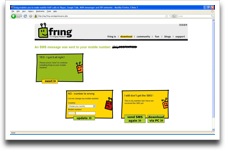
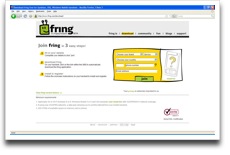
Click on thumbnail to see fullsize image
You can download the fring installer straight to your phone or you can choose to download it on your PC and then transfer it to your phone. If you choose the former, you will need to visit http://www.fring.com/download and provide your phone make/model, mobile phone number and email ID (optional). Immediately thereafter, you will receive an SMS with a download link on your handset. You can also visit http://wap.fring.com from your phone.
If you do not receive that SMS or if you do not wish to provide your mobile number, you can also download the installer on your PC from at http://www.fring.com/download/Symbian_UIQ_Windows_Mobile/
Installation and registration
I chose the former. The next page on the desktop was a confirmation screen. Within seconds, my Sony Ericsson p990i buzzed. I opened the message and launched a link in my phone’s browser.
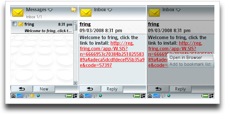
Click on thumbnail to see fullsize image
Then I was taken through the usual installation rigmarole – a series of OKs, really. Uninstalling is as easy as uninstalling any application from your phone.
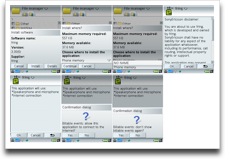
Click on thumbnail to see fullsize image
Immediately upon completion of installation, you need to register as a fringster. A simple unassuming registration screen asks you for a User ID, a Password and a Username (a nickname, really). Fill it in and you’re ready to go.
The “default†screen of fring is a buddy list. My buddy list had only one user – called “fring test callâ€.
Next, I selected “Configure Services†from the main menu to add my IM/VoIP accounts to fring. I was able to choose my IM/VoIP account (see following picture). Fill in your details and voila! You’re signed into to your IM/VoIP account. You can also sign in to your account from SIP providers like Gizmo, VoIP Stunt, etc.
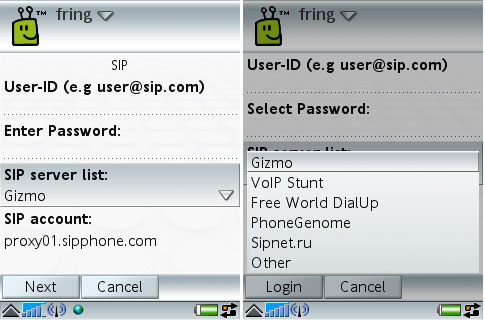
Once you register your IM/VoIP account(s), your buddy list gets populated with all your IM/VoIP contacts in one consolidated list.
Usage
Right – this is where the rubber meets the road.
The big fring icon on the top left corner of the main screen shows the overall connection status. Green means you’re connected to the fring service. Any other color means you’re not. Moreover, a status bar near the bottom left of the main screen shows individual connection statuses for each of your IM/VoIP services.
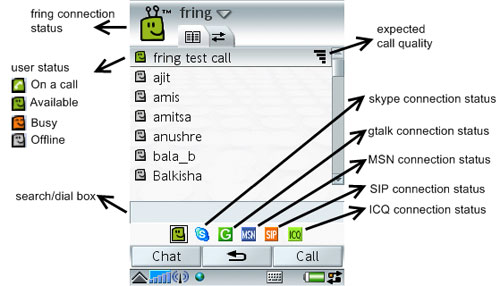
The statuses of your buddies are shown just before their names. They can be either online, offline, busy or on a call (see red box in the following screen). Too bad, fring doesn’t color code buddies by their network – they all appear one below the other.
You can also see a call quality indicator near your buddies’ names, much like your handset’s network quality indicator. This is an indicator of the expected call quality between you and your buddy based on the connections you are on. If both you and your buddy were on a Wi-Fi connection, for example, the indicator would be quite healthy. On the other hand, if both of you were on a regular GPRS connection, the indicator would probably show only one bar and that usually means it’s a bad idea to place a VoIP call to that buddy. Of course, this works only when the other buddy’s a fringster too.
To look for the buddy you want to chat/talk with, you can browse through your buddy list or type the first few characters of the buddy name in the search box.

To chat with an online buddy, just select the buddy and click on chat. Chats open in their own tabs so you can have multiple concurrent tabs. My chats worked fine. The handset’s dictionary (with my custom words) & all language options were available.
To place a VoIP call, click on the call button, instead. In my tests, I made a few fring-to-IM VoIP calls with buddies who were logged into their IM clients from their PCs (I was connected on my home Wi-Fi network). I also made a couple of SkypeOut calls using my SkypeOut account. The call quality in every case was as good as a regular phone call or a regular internet VoIP call. I also have a SkypeIn subscription and asked a friend to dial from SkypeIn phone number from her regular phone. This, while I was signed into Skype from fring. Within seconds, I got an incoming call on fring and I was able to talk clearly with my friend.
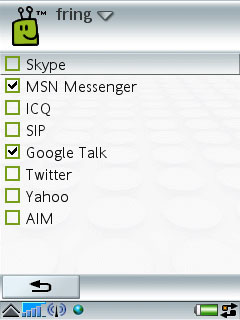
I also signed into my twitter account and was able to tweet effortlessly. There’s no support for Jaiku, though.
Features and Impressions
Fring is a native phone OS application and not Java. On my p990i, I found fring very stable even after several hours of usage and running in the background. Even when I got a regular incoming GSM call during a fring call, fring was able to relegate itself to the background very gracefully without crashing.
On the other hand, as long as fring runs in the foreground or the background, a data connection remains active and that can mean creeping consumption of battery life and more importantly, data. The folks at fring have put up an estimated data consumption chart on fring.com (see chart below).

Click on thumbnail to see fullsize image
The call and chat functions work absolutely fine. I was able to test call quality on Wi-Fi and chat on regular low-speed GPRS connections. The application can became slightly sluggish, though, in longer chat sessions (I observed this after my chat conversation had lasted for some 200 messages & 20 minutes of usage). But that’s largely a function of the phone’s power and not so much the software’s. Besides, all one needs to do to work around this, is to close that tab and continue chatting in a new tab.
Fring provides an option to import/display your phone contacts as buddies in your list. You can then choose to place regular phone calls or SkypeOut/SIP calls to those contacts *from within* fring. That, in my opinion, is a very handy feature especially for users who’re on high speed 3G or Wi-Fi networks. There is a history feature too.
Conspicuously absent from fring’s impressive repertoire, though, are buddy list management options. You cannot add or delete any IM buddy (you have to go back to your desktop for that). Only other fringsters can be added or deleted from the buddy list. There is an option to “add new contactâ€, but that only allows you to add fringsters by sending them an SMS invitation.
I was unable to test fring’s acclaimed auto-roam feature that allows automatic movement from a 3G/EDGE/GPRS network to a Wi-Fi network when fring finds one. So, if you’re out on the street connected to fring through your mobile data network and you walk into a coffee shop with a Wi-Fi hotspot, fring would put you on the Wi-Fi network automatically. From what I’ve read online, it appears this feature works rather well.
If you’re an IM, Twitter or Skype user (that’s pretty much all of us, ain’t it?), then fring is a must-have for you. According to its cofounders, fring was born “out of a desire to fundamentally change the way people communicateâ€. I’m not too sure it’s reached that far yet, but it has certainly integrated IM, VoIP and mobile telephony in a way that no other application has ever done.
Keenso Foldable Headset Over Ear Stereo Headsets with Memory Card, Wireless Gaming Headphones for Android iOS Symbian, Stable Transmission, HighQuality CD Sound, Black
$21.74 (as of 12/24/2025 16:58 GMT -06:00 - More infoProduct prices and availability are accurate as of the date/time indicated and are subject to change. Any price and availability information displayed on [relevant Amazon Site(s), as applicable] at the time of purchase will apply to the purchase of this product.)Nokia E52 Unlocked Cell Phone w/GPS, WiFi, Bluetooth, Symbian/International Version
$279.00 (as of 12/24/2025 12:35 GMT -06:00 - More infoProduct prices and availability are accurate as of the date/time indicated and are subject to change. Any price and availability information displayed on [relevant Amazon Site(s), as applicable] at the time of purchase will apply to the purchase of this product.)Product Information
| Price: | 0.0 |
| Manufacturer: | fring |
| Requirements: |
|
| Pros: |
|
| Cons: |
|

![[VERSATILE AND COMPATIBLE] Compatible with Android, IOS, , and Symbian devices, ensuring broad compatibility with a wide range of smartphones and tablets. [ENHANCED CONTROL AND FUNCTIONALITY] Features two-way - chatting, music playback control, movie...](https://m.media-amazon.com/images/I/41tJn2sfMRS._SL160_.jpg)

Gadgeteer Comment Policy - Please read before commenting
nice comprehensive review. have you ever tried EQO for free mobile IM? it’s similar to fring, supports all the major IM services, and also offers mobile VoIP and cheap/free texts – check it out
EQO Website.
[Edited at May 26, 2008 13:51:38 PM.]
Fring still lacks a basic feature: disabling temporarily one of your services. If you have, say, gtalk, msn and sip turned and you want to disconnect sip without having to turn off the app you can’t, you just can cancel the login in the settings and then write them again.